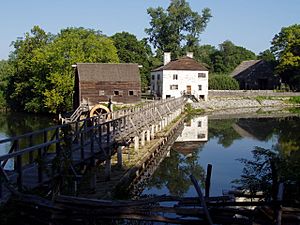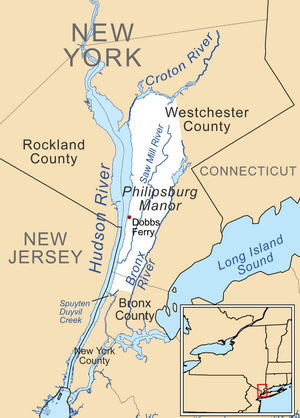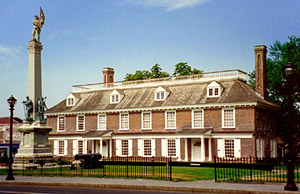Philipsburg Manor facts for kids
Philipsburg Manor was a huge estate, or manor, located north of New York City in Westchester County. This area was part of the Province of New York when it was still a British colony.
A man named Frederick Philipse I, who was born in the Netherlands, first bought land for the manor in 1672. He bought it with two partners from Adriaen van der Donck, who had a Dutch land grant called a patroonship. Philipse later bought out his partners and added even more land. In 1693, the King of England gave him a special paper called a royal charter. This made his 52,000 acres (21,000 ha) estate an official manor, and he became its first lord.
After Frederick Philipse I died, the manor was split between his son and grandson. They both continued to develop the estate. The Philipses were involved in many businesses, including the slave trade. They used enslaved people to build most of the structures on the Philipsburg property. The people who farmed the land, called tenant farmers, came from many different European countries.
During the American Revolution, the manor's land was taken away. The third and last lord, Frederick Philipse III, was a Loyalist, meaning he supported the British King. New York's revolutionary government declared him a traitor in 1779. The estate's land was used to help pay for the fight against the British. Later, it was sold in pieces. Some of the original buildings are still standing today. These include the Philipsburg Manor House in Sleepy Hollow, Philipse Manor Hall (the family's main home) in Yonkers, and the Old Dutch Church of Sleepy Hollow. All of these are important National Historic Landmarks.
Contents
History of Philipsburg Manor

The land that became Philipsburg Manor was first bought from Adriaen van der Donck. He had received a large land grant, or patroonship, when the area was called New Netherland under Dutch rule. This was before the English took over in 1664. Frederick Philipse I, along with Thomas Delavall and Thomas Lewis, bought the first parts of the land in 1672. This area is now northern Yonkers.
Between 1680 and 1686, Philipse bought more land from Native American tribes like the Wiechquaeskeck and Sinsink. This made the property much larger, stretching both north and south. He also bought a small piece of land from the Tappans on the west side of the Hudson River. The manor eventually covered about 52,000 acres (21,000 ha) of land. Philipse also bought out his partners' shares during this time.
Manor Boundaries and Power
The estate's borders were the Spuyten Duyvil Creek to the south, the Croton River to the north, the Hudson River to the west, and the Bronx River to the east. In 1693, Philipse received a royal charter from the King. This officially created the Manor of Philipsburg and made him the first lord of the manor. Philipsburg became one of the richest and most powerful families in the colony. It was one of four main manors, along with Rensselaerswyck, Cortlandt, and Livingston.
When Philipse died in 1702, the manor was divided. His son, Adolphus Philipse, received the Upper Mills property, which stretched from Dobbs Ferry to the Croton River. His grandson, Frederick Philipse II, received the Lower Mills. This part included the family's main home, Philipse Manor Hall, located where the Neperhan River (now the Saw Mill River) met the Hudson River. The two parts of the manor were joined again when Adolphus died. Frederick II's son, Frederick III, became the third lord of the manor in 1751.
Building and Life on the Manor
The Philipses used enslaved people to build many structures at both the Upper and Lower Mills. At the Upper Mills, they built two gristmills (for grinding grain) on the Pocantico River. They also built a stone manor house, a wharf (a place for boats), a cooperage (for making barrels), and a bake house. Most of these buildings were finished by 1697, including the Old Dutch Church of Sleepy Hollow, which is now a National Historic Landmark. At the Lower Mills, a gristmill and Philipse Manor Hall were built on the north bank of the Neperhan River. The Philipses wanted the manor to be a major center for farming, and they succeeded.
During the 1700s, many tenant farmers moved to the manor. They came from places like Great Britain, the Netherlands, France, and Germany, as well as other parts of North America. By the start of the American Revolution in 1776, the population had grown to about 1,000 people, up from 200 when Frederick I died.
The American Revolution and After
Several years into the American Revolution, Frederick Philipse III, who was a Loyalist, was declared a traitor by the new government of New York. This meant his family's property was taken away in 1779. The manor was used as a way to raise money for the American fight for independence.
After the war, the land was sold off in a public auction to 287 different buyers. The largest part, about 750 acres (300 ha) at the Upper Mills, was bought by Gerard Beekman. The lower part, including Manor Hall, went to Cornelius Low. This part was sold to many different owners over the years. In 1951, it was bought by Sleepy Hollow Restorations (now called Historic Hudson Valley). A generous person named John D. Rockefeller Jr. paid for the restoration of about 20 acres (8.1 ha), which is now the Philipsburg Manor historic site. Philipse Manor Hall was even used as Yonkers City Hall from 1872 to 1908. Both homes became National Historic Landmarks on November 5, 1961, and are now house museums where people can visit and learn about history.
Legacy
In 2004, Philipsburg Manor was added to the African American Heritage Trail of Westchester County. This trail includes 14 important sites, such as the Rye African-American Cemetery, Saint Paul's Church National Historic Site, and the Jay Estate.



